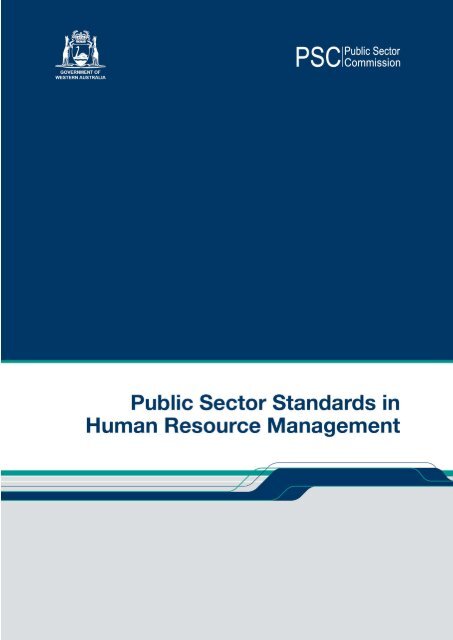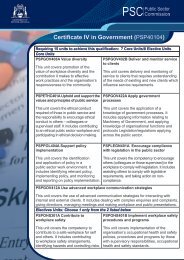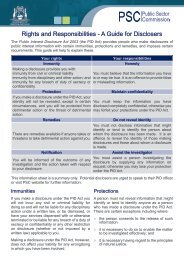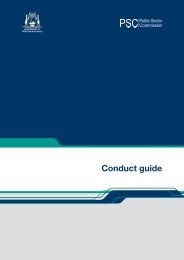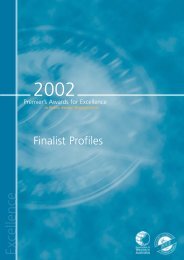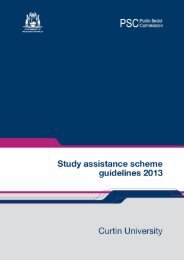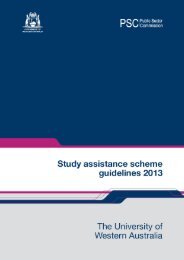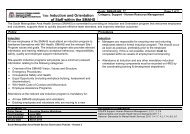Standards in Human Resource Management - Public Sector ...
Standards in Human Resource Management - Public Sector ...
Standards in Human Resource Management - Public Sector ...
- No tags were found...
You also want an ePaper? Increase the reach of your titles
YUMPU automatically turns print PDFs into web optimized ePapers that Google loves.
Contact detailsLocation and postal address<strong>Public</strong> <strong>Sector</strong> CommissionDumas House, 2 Havelock StreetWEST PERTH WA 6005Locked Bag 3002WEST PERTH WA 6872Telephone, fax and emailAdvisory l<strong>in</strong>e (08) 6552 8888Fax: (08) 6552 8501Toll Free: 1800 676 607Email: adm<strong>in</strong>@psc.wa.gov.auWeb: www.publicsector.wa.gov.auFeedback or compla<strong>in</strong>tsIf you would like to provide feedback or compla<strong>in</strong>ts about PSC services, products or staffplease contact us on adm<strong>in</strong>@psc.wa.gov.au, or call (08) 6552 8500.Availability <strong>in</strong> other formatsThis publication is available <strong>in</strong> PDF, Word and HTML at www.publicsector.wa.gov.auFor people with disabilities, this document is available <strong>in</strong> alternative formats on request.2
ContentsIntroduction .......................................................................................................................... 4Coverage ............................................................................................................................. 4Implementation .................................................................................................................... 5Assistance ............................................................................................................................ 5Performance <strong>Management</strong> Standard .................................................................................. 6Redeployment Standard ...................................................................................................... 8Term<strong>in</strong>ation Standard ........................................................................................................ 11Discipl<strong>in</strong>e Standard ............................................................................................................ 13Grievance Resolution Standard ........................................................................................ 15Commissioner’s Instruction - Employment Standard........................................................ 183
IntroductionThe <strong>Public</strong> <strong>Sector</strong> <strong>Management</strong> Act 1994 (PSM Act) established an <strong>in</strong>dependentstatutory office of the <strong>Public</strong> <strong>Sector</strong> Commissioner (PSC). The Commissioner hasresponsibility to establish m<strong>in</strong>imum standards of merit, equity and probity for specifiedhuman resource management activities.The <strong>Public</strong> <strong>Sector</strong> <strong>Standards</strong> <strong>in</strong> <strong>Human</strong> <strong>Resource</strong> <strong>Management</strong> (the <strong>Standards</strong>) set outthe m<strong>in</strong>imum standards required of all Western Australian public sector bodies andemployees.The Performance <strong>Management</strong> Standard, Discipl<strong>in</strong>e Standard, Grievance ResolutionStandard, Term<strong>in</strong>ation Standard and Redeployment Standard have operated s<strong>in</strong>ce 1July 2001.The Commissioner’s Instruction: The Employment Standard has been effective s<strong>in</strong>ce 21February 2011.This document <strong>in</strong>cludes:• the six <strong>Standards</strong>, <strong>in</strong>clud<strong>in</strong>g the Commissioner’s Instruction: EmploymentStandard• explanatory notes for five <strong>Standards</strong> (the Explanatory Notes do not form part ofthe <strong>Standards</strong>)• term<strong>in</strong>ology applicable to the <strong>Standards</strong> (Term<strong>in</strong>ology does not form part of the<strong>Standards</strong>).CoverageThroughout this document, public sector bodies are referred to as employ<strong>in</strong>g authorities.All employ<strong>in</strong>g authorities and employees must comply with the <strong>Standards</strong>.Schedule 1 of the PSM Act lists entities not covered by the <strong>Standards</strong>, <strong>in</strong>clud<strong>in</strong>g:• elected officials (for example, members of Parliament and local governmentcouncil representatives)• local governments authorities• sworn members of the Western Australia Police Service (police officers)• universities• any court or tribunal established under a written law• some corporatised bodies such as the port authorities and the Water Corporation.These bodies and their employees are covered by other legislation.4
ImplementationEmploy<strong>in</strong>g authorities are responsible for the development and implementation ofhuman resource management policies and procedures consistent with the <strong>Standards</strong>.Employ<strong>in</strong>g authorities should:• raise awareness of employees about the <strong>Standards</strong>• ensure human resource policies and practices comply with the <strong>Standards</strong>• report annually on compliance with the <strong>Standards</strong> (s.31 of the PSM Act).The Commissioner monitors compliance with the <strong>Standards</strong> and reports to Parliamentannually.AssistanceFor assistance with the <strong>Standards</strong> or their application, contact the <strong>Public</strong> <strong>Sector</strong>Commission’s Advisory L<strong>in</strong>e on 6552 8888.5
Performance <strong>Management</strong> StandardOutcomeThe performance of all employees is fairly assessed to achieve the work-relatedrequirements of the public sector body while pay<strong>in</strong>g proper regard to employee <strong>in</strong>terests.The StandardThe m<strong>in</strong>imum standard of merit, equity and probity is met for performance managementif:• an employee is <strong>in</strong>formed about how their performance will be managed and theresults of their performance assessment• a proper assessment of the employee’s performance takes <strong>in</strong>to account both thework-related requirements of the job and identified employee <strong>in</strong>terests• processes, decisions and actions are impartial, transparent and capable ofreview.Explanatory notesThe explanatory notes are a guide and are not part of the Performance <strong>Management</strong>Standard.ApplicationThe Standard applies to the performance management of all employees <strong>in</strong> the publicsector, irrespective of level. It assists public sector bodies to establish processes bywhich employees can achieve their potential and the employ<strong>in</strong>g authority’s bus<strong>in</strong>essneeds.The Standard does not apply to sub-standard performance or discipl<strong>in</strong>ary action. Whileperformance management processes may identify performance deemed below the levelrequired, and could result <strong>in</strong> discipl<strong>in</strong>ary action, specific legislative or common lawprovisions apply to sub-standard performance and discipl<strong>in</strong>e.Work-related requirementsWork related requirements are the skills, knowledge and abilities required for the job,which may <strong>in</strong>clude the bus<strong>in</strong>ess needs sought by the employ<strong>in</strong>g authority.6
Employee <strong>in</strong>terestsAlthough the Standard requires the employ<strong>in</strong>g authority to identify employee <strong>in</strong>terests, itdoes not oblige the employer to assent to them. They assist the employ<strong>in</strong>g authority tomake an <strong>in</strong>formed assessment about employee performance by tak<strong>in</strong>g such <strong>in</strong>terests<strong>in</strong>to consideration.Employee <strong>in</strong>terests could <strong>in</strong>clude:• career considerations• professional development needs• personal circumstances.MethodAn employ<strong>in</strong>g authority may use several methods to assess and manage performance,depend<strong>in</strong>g on the specific needs of employees or occupational groups. Whatevermethods are used, they should be capable of identify<strong>in</strong>g various levels of performance.Employees must be <strong>in</strong>formed about how their performance will be assessed andrecorded. Once a method is adopted, it must be applied consistently to that employee oroccupational group.ConfidentialityInformation produced dur<strong>in</strong>g the performance management process is kept <strong>in</strong> trust anddivulged only to those with a need to know, with due regard to the requirements of theFreedom of Information Act 1992.ReviewDocumentation about an employee’s performance should describe clearly and conciselythe grounds upon which the assessment is made.<strong>Public</strong> <strong>Sector</strong> <strong>Management</strong> (Breaches of <strong>Public</strong> <strong>Sector</strong> <strong>Standards</strong>)Regulations 2005The process used to manage an employee’s performance is subject to the breach ofStandard procedures. Employees have up to 10 work<strong>in</strong>g days from first becom<strong>in</strong>g awareof the reviewable decision to lodge a breach claim, or 30 days after the decision wasmade, whichever period expires first.Refer to PSC website for the Agency Guide, Claimant’s Guides and the l<strong>in</strong>k to theRegulations at www.publicsector.wa.gov.auObligationsThe Standard does not override specific requirements applicable to performancemanagement <strong>in</strong> the public sector, which may <strong>in</strong>clude:• Commissioner’s Instructions issued under the PSM Act• sub-standard performance procedures, as specified <strong>in</strong> Part 5, Division 2 of thePSM Act• any other sub-standard performance process specified <strong>in</strong> an applicable award or<strong>in</strong>dustrial agreement.7
Redeployment StandardOutcomeRedeployment decisions are equitable and take <strong>in</strong>to account the organisation’s workrelatedrequirements and employee <strong>in</strong>terests.The StandardThe m<strong>in</strong>imum standard of merit, equity and probity is met for redeployment if:• decisions are based on a proper assessment of the work-related requirements ofthe public sector bodies <strong>in</strong>volved and identified employee <strong>in</strong>terests.• redeployees are <strong>in</strong>formed about their future options and how the process is to bemanaged.• decisions are impartial, transparent and capable of review.Explanatory notesThe explanatory notes are a guide and are not part of the Redeployment Standard.ApplicationThe Standard applies to the process used by an employ<strong>in</strong>g authority to make decisionsabout the treatment and management of affected employees.The Standard is effective between the time the job is abolished or the person is deemedsurplus, until the action on their future is completed. This may <strong>in</strong>clude transfer,registered employee status or severance.The Standard does not apply to:• action taken about a ‘registered employee’, as provided for <strong>in</strong> the <strong>Public</strong> <strong>Sector</strong><strong>Management</strong> (Redeployment and Redundancy) Regulations 1994• sub-standard performance or discipl<strong>in</strong>ary action. Redeployment must not be usedto identify or relocate employees when performance is considered unsuitable• decisions by employ<strong>in</strong>g authorities to abolish jobs.8
Decision to abolish a jobWhile an employ<strong>in</strong>g authority’s decision to identify a job as surplus is not covered by theStandard, its actions must be consistent with the general pr<strong>in</strong>ciples <strong>in</strong> sections 8 and 9of the PSM Act. It rema<strong>in</strong>s open to an employee aggrieved by such a decision to lodge agrievance with the employ<strong>in</strong>g authority.The Commissioner monitors and reports on the extent to which employ<strong>in</strong>g authoritiesproperly exam<strong>in</strong>e such compla<strong>in</strong>ts.Work-related requirementsWork-related requirements refer to the skills, knowledge and abilities required of the job,<strong>in</strong>clud<strong>in</strong>g consideration of the bus<strong>in</strong>ess needs of the relevant employ<strong>in</strong>g authorities.Employee <strong>in</strong>terestsIdentify<strong>in</strong>g employee <strong>in</strong>terests does not oblige the employ<strong>in</strong>g authority to assent to them.They assist the employ<strong>in</strong>g authority to make <strong>in</strong>formed decisions about the efficient andeffective deployment of human resources. However, the Standard requires thatemployee <strong>in</strong>terests are fairly assessed and considered <strong>in</strong> the decision-mak<strong>in</strong>g process.Employee <strong>in</strong>terests could <strong>in</strong>clude:• career considerations• personal circumstances• workplace location (for example, metropolitan to country location etc).<strong>Management</strong>The redeployee rema<strong>in</strong>s the responsibility of the employ<strong>in</strong>g authority throughout theprocess.Employees who have been identified as surplus are to be advised about access toappropriate support services and <strong>in</strong>formed about their rights and responsibilities.Decisions to relocate an employee must not result <strong>in</strong> a loss of service cont<strong>in</strong>uity oremployment tenure.If an employ<strong>in</strong>g authority is unable to f<strong>in</strong>d alternative employment for the redeployee, theperson may become a ‘registered employee’, as provided for <strong>in</strong> the <strong>Public</strong> <strong>Sector</strong><strong>Management</strong> (Redeployment and Redundancy) Regulations 1994.9
ConfidentialityInformation produced dur<strong>in</strong>g the redeployment process is kept <strong>in</strong> trust and divulged onlyto those with a need to know, with due regard to the requirements of the Freedom ofInformation Act 1992.ReviewDocumentation about a redeployment decision should describe clearly and concisely thegrounds upon which the decision was made.<strong>Public</strong> <strong>Sector</strong> <strong>Management</strong> (Breaches of <strong>Public</strong> <strong>Sector</strong> <strong>Standards</strong>)Regulations 2005Once a reviewable decision is made about the treatment and management of anemployee whose job has been abolished or who is deemed surplus, the process issubject to the breach of Standard procedures. Employees have up to 10 work<strong>in</strong>g days tolodge a breach claim from first becom<strong>in</strong>g aware of the decision, or 30 days after thedecision was made, whichever period expires first.Refer to PSC website for the Agency Guide, Claimant’s Guides and the l<strong>in</strong>k to theRegulations at www.publicsector.wa.gov.auObligationsThe Standard does not override specific requirements applicable to redeployment <strong>in</strong> thepublic sector, which may <strong>in</strong>clude:• the <strong>Public</strong> <strong>Sector</strong> <strong>Management</strong> (Redeployment and Redundancy) Regulations1994• redeployment and redundancy provisions of Part 6 of the PSM Act• Commissioner’s Instructions issued under the PSM Act.10
Term<strong>in</strong>ation StandardOutcomeTerm<strong>in</strong>ation decisions are fair and all entitlements are provided.The StandardThe m<strong>in</strong>imum standard of merit, equity and probity is met for term<strong>in</strong>ation if:• decisions are based on a proper assessment of the public sector body’srequirements and employee’s circumstances.• employees are <strong>in</strong>formed of their rights, entitlements and responsibilities about theterm<strong>in</strong>ation process.• decisions are impartial, transparent and capable of review.Explanatory notesThe explanatory notes are a guide and are not part of the Term<strong>in</strong>ation Standard.ApplicationThe Standard applies to the process used by an employ<strong>in</strong>g authority to reach decisionsabout term<strong>in</strong>ation of an employee’s employment and/or to respond to an employee’srequest for cessation of employment.Cessation of employment <strong>in</strong>cludes:• resignation• retirement• retirement on the grounds of ill-health• completion of a fixed term contract of service• severance (i.e. redundancy, voluntary severance).The Standard does not apply to the cessation of employment as a consequence of substandardperformance or discipl<strong>in</strong>ary action. Other legislation applies.Rights and entitlementsEmployees should be <strong>in</strong>formed about their entitlements prior to the cessation ofemployment.Employee rights and entitlements are mentioned <strong>in</strong> the enabl<strong>in</strong>g legislation, awards,employment contracts or <strong>in</strong>dustrial agreements. Employ<strong>in</strong>g authorities must act <strong>in</strong>accordance with these terms and conditions.11
ConfidentialityInformation produced dur<strong>in</strong>g the term<strong>in</strong>ation process is kept <strong>in</strong> trust and divulged only tothose with a need to know, with due regard to the requirements of the Freedom ofInformation Act 1992.ReviewDocumentation about the term<strong>in</strong>ation decision should describe clearly and concisely thegrounds upon which the decision was made.<strong>Public</strong> <strong>Sector</strong> <strong>Management</strong> (Breaches of <strong>Public</strong> <strong>Sector</strong> <strong>Standards</strong>) Regulations2005.Once a reviewable decision is made about the cessation of an employment contract, theprocess is subject to the breach of Standard procedures. Employees have up to 10work<strong>in</strong>g days to lodge a breach claim from first becom<strong>in</strong>g aware of the decision, or 30days after the decision was made, whichever period expires first.Refer to PSC website for the Agency Guide, Claimant’s Guides and the l<strong>in</strong>k to theRegulations at www.publicsector.wa.gov.auObligationsThe Standard does not override specific requirements applicable to term<strong>in</strong>ation <strong>in</strong> thepublic sector, which may <strong>in</strong>clude:• Commissioner’s Instructions issued under the PSM Act• unfair dismissal legislation adm<strong>in</strong>istered by the Industrial Relations Commission• any dispute resolution process specified <strong>in</strong> an applicable award or <strong>in</strong>dustrialagreement.12
Discipl<strong>in</strong>e StandardOutcomeThe discipl<strong>in</strong>e process observes procedural fairness.The StandardThe m<strong>in</strong>imum standard of merit, equity and probity is met for discipl<strong>in</strong>e if:• decisions are based on a proper assessment of the facts and circumstancesprevail<strong>in</strong>g at the time of the suspected breach of discipl<strong>in</strong>e• the employ<strong>in</strong>g authority ensures procedural fairness is applied to all parties• decisions are impartial, transparent and capable of review.Explanatory notesThe explanatory notes are a guide and are not part of the Discipl<strong>in</strong>e Standard.ApplicationThe Standard applies to the discipl<strong>in</strong>ary process used by an employ<strong>in</strong>g authorityfollow<strong>in</strong>g a suspected breach of the employment contract by an employee.The Standard does not apply to:• judg<strong>in</strong>g the merits of the facts and circumstances of the particular case• sub-standard performance• the appropriateness of any sanction imposed by the employ<strong>in</strong>g authority at theconclusion of a discipl<strong>in</strong>ary process.Rights and obligationsEmploy<strong>in</strong>g authorities should <strong>in</strong>form employees about their rights and responsibilitiesand advise about access to appropriate support services. Employ<strong>in</strong>g authorities may f<strong>in</strong>dit useful to obta<strong>in</strong> appropriate advice about the conduct of a discipl<strong>in</strong>ary procedurebefore proceed<strong>in</strong>g.13
PeriodThe Standard does not impose a time period to complete a discipl<strong>in</strong>ary process.All parties should attempt to complete a discipl<strong>in</strong>ary process as quickly as possible. If itcannot be completed with<strong>in</strong> a reasonable time, the parties should be <strong>in</strong>formed about thedelay and the reasons for it.It is open to an employee to seek relief about an alleged undue delay of a discipl<strong>in</strong>aryprocess. This may <strong>in</strong>clude the Industrial Relations Commission, or the dispute resolutionprocess specified <strong>in</strong> the applicable award or <strong>in</strong>dustrial agreement.ConfidentialityInformation produced dur<strong>in</strong>g the discipl<strong>in</strong>e process is kept <strong>in</strong> trust and divulged only tothose with a need to know, with due regard to the requirements of the Freedom ofInformation Act 1992.ReviewDocumentation about a discipl<strong>in</strong>e decision should describe clearly and concisely thegrounds upon which the decision was made.<strong>Public</strong> <strong>Sector</strong> <strong>Management</strong> (Breaches of <strong>Public</strong> <strong>Sector</strong> <strong>Standards</strong>)Regulations 2005In accordance with s.96 of the PSM Act, the breach of Standard procedures do not applyto the Discipl<strong>in</strong>e Standard.Refer to PSC website for the Agency Guide, Claimant’s Guides and the l<strong>in</strong>k to theRegulations at www.publicsector.wa.gov.auObligationsThe Standard does not override specific requirements applicable to discipl<strong>in</strong>e <strong>in</strong> thepublic sector, which may <strong>in</strong>clude:• discipl<strong>in</strong>e procedures specified <strong>in</strong> Part 5, Division 3 of the PSM Act• Commissioner’s Instructions issued under the PSM Act that relate to Discipl<strong>in</strong>e• unfair dismissal legislation adm<strong>in</strong>istered by the Industrial Relations Commission• any dispute resolution process specified <strong>in</strong> an applicable award or <strong>in</strong>dustrialagreement.14
Grievance Resolution StandardOutcomeThe process used by an employ<strong>in</strong>g authority to resolve or redress employee grievancesis fair.The StandardThe m<strong>in</strong>imum standard of merit, equity and probity is met for grievance resolution if:• employees are <strong>in</strong>formed of their rights and responsibilities <strong>in</strong> the grievanceresolution process• the process is based on a proper consideration of the facts and circumstancesprevail<strong>in</strong>g at the time of the grievance• decisions are impartial, transparent and capable of review.Explanatory notesThe explanatory notes are a guide and are not part of the Grievance ResolutionStandard.ApplicationThe Standard applies to the process used by an employ<strong>in</strong>g authority to resolve orredress an employee’s grievance.The Standard does not apply to:• judg<strong>in</strong>g the merits of the grievance• sub-standard performance or discipl<strong>in</strong>ary action• allegations of victimisation follow<strong>in</strong>g the lodgement of a grievance.While allegations of victimisation as a consequence of lodg<strong>in</strong>g a grievance cannot bedealt with under the Standard, a compla<strong>in</strong>t could be lodged with the employ<strong>in</strong>g authority.The Commissioner monitors and reports on the extent to which employ<strong>in</strong>g authoritiesproperly exam<strong>in</strong>e such compla<strong>in</strong>ts.MethodsAn employ<strong>in</strong>g authority may use several methods to resolve or redress employeegrievances. Once a method is adopted, it must be applied consistently.15
Lodg<strong>in</strong>g a grievanceThe Standard does not require employees to lodge a grievance with their employ<strong>in</strong>gauthority, <strong>in</strong> any particular way (for example, <strong>in</strong> writ<strong>in</strong>g). It is the responsibility ofemploy<strong>in</strong>g authorities to <strong>in</strong>form employees about their rights, how to lodge a grievance,and how grievances will be managed. Employ<strong>in</strong>g authorities must ensure that when agrievance is brought to their attention, that a genu<strong>in</strong>e attempt is made to resolve orredress it.The employee bear<strong>in</strong>g the grievance has a responsibility to:• ensure the relevant person is appropriately made aware of the grievance; and• provide sufficient <strong>in</strong>formation to enable the employ<strong>in</strong>g authority to assess thegrievance.PeriodThe Standard does not impose a time period to complete a grievance resolutionprocess.All parties should attempt to complete a grievance resolution process as quickly aspossible. If it cannot be completed with<strong>in</strong> a reasonable time, the parties should be<strong>in</strong>formed about the delay and the reasons for it.ConfidentialityInformation produced dur<strong>in</strong>g the grievance resolution process is kept <strong>in</strong> trust anddivulged only to those with a need to know, with due regard to the requirements of theFreedom of Information Act 1992.ReviewDocumentation about the grievance resolution decision should describe clearly andconcisely the grounds upon which the decision was made.<strong>Public</strong> <strong>Sector</strong> <strong>Management</strong> (Breaches of <strong>Public</strong> <strong>Sector</strong> <strong>Standards</strong>)Regulations 2005Once the f<strong>in</strong>al reviewable decision is made, the Regulations require employ<strong>in</strong>gauthorities to notify the employee who made the grievance and any employee that wasthe subject of the grievance that they may make a breach of Standard claim, and howthat claim may be made.Refer to PSC website for the Agency Guide, Claimant’s Guides and the l<strong>in</strong>k to theRegulations at www.publicsector.wa.gov.au16
ObligationsThe Standard does not override specific requirements applicable to grievance resolution<strong>in</strong> the public sector, which may <strong>in</strong>clude:• Commissioner’s Instructions issued under the PSM Act• any dispute resolution process specified <strong>in</strong> an applicable award or <strong>in</strong>dustrialagreement.Term<strong>in</strong>ologyFor the purpose of the <strong>Public</strong> <strong>Sector</strong> <strong>Standards</strong> <strong>in</strong> <strong>Human</strong> <strong>Resource</strong> <strong>Management</strong>(exclud<strong>in</strong>g the Employment Standard) terms are def<strong>in</strong>ed as follows:Reviewable decision Means a decision made by a public sector body as aresult of the completion of a process to which a <strong>Public</strong><strong>Sector</strong> Standard applies.Registered employee As provided for by the <strong>Public</strong> <strong>Sector</strong> <strong>Management</strong>(Redeployment and Redundancy) Regulations 1994.Job Reference to job <strong>in</strong> the <strong>Standards</strong> refers to an office, post,position, item or function <strong>in</strong> a public sector body,department or organisation.Proper assessment A genu<strong>in</strong>e and thorough exam<strong>in</strong>ation that takes <strong>in</strong>toaccount all relevant facts and circumstances that arereasonably available and known at the time of thedecision.17
Statement of <strong>in</strong>tentCommissioner’s Instruction -Employment StandardThis Commissioner’s Instruction - Employment Standard establishes the m<strong>in</strong>imumstandards of merit, equity and probity to be complied with by the employ<strong>in</strong>g authority ofeach public sector body when fill<strong>in</strong>g a vacancy.Scope and applicationThis CI applies to public service officers appo<strong>in</strong>ted under Part 3 of the <strong>Public</strong> <strong>Sector</strong><strong>Management</strong> Act 1994 (PSMA) and to employees otherwise employed by employ<strong>in</strong>gauthorities of public sector bodies, as def<strong>in</strong>ed <strong>in</strong> the PSMA.This CI repeals under section 21(2) of the PSMA (and replaces):• <strong>Public</strong> <strong>Sector</strong> <strong>Standards</strong> <strong>in</strong> <strong>Human</strong> <strong>Resource</strong> <strong>Management</strong> 2001 - Recruitment,Selection and Appo<strong>in</strong>tment Standard;• <strong>Public</strong> <strong>Sector</strong> <strong>Standards</strong> <strong>in</strong> <strong>Human</strong> <strong>Resource</strong> <strong>Management</strong> 2001 - TransferStandard;• <strong>Public</strong> <strong>Sector</strong> <strong>Standards</strong> <strong>in</strong> <strong>Human</strong> <strong>Resource</strong> <strong>Management</strong> 2001 - SecondmentStandard; and• <strong>Public</strong> <strong>Sector</strong> <strong>Standards</strong> <strong>in</strong> <strong>Human</strong> <strong>Resource</strong> <strong>Management</strong> 2001 – TemporaryDeployment (Act<strong>in</strong>g) Standard.ReferenceWhen mak<strong>in</strong>g employment decisions and exercis<strong>in</strong>g employment powers and functionsthe employ<strong>in</strong>g authority of each public sector body and its employees must comply withthe m<strong>in</strong>imum standards of merit, equity and probity established by the Commissionerunder the Employment Standard, set out below, and the CI on Fill<strong>in</strong>g a <strong>Public</strong> <strong>Sector</strong>Vacancy. This requirement is <strong>in</strong> addition to compliance with the PSMA (particularlysection 8(1)(a), (b) and (c), section 8(3) and section 9), the Western Australian <strong>Public</strong><strong>Sector</strong> Code of Ethics and other relevant legislation.Support<strong>in</strong>g <strong>in</strong>formation produced by the <strong>Public</strong> <strong>Sector</strong> Commission may assist theemploy<strong>in</strong>g authorities of public sector bodies fill vacancies. Such material is explanatoryand does not form part of the legislative framework.18
The Employment Standard(Effective on and from 21 February 2011)The Employment Standard applies when fill<strong>in</strong>g a vacancy (by way of recruitment,selection, appo<strong>in</strong>tment, secondment, transfer and temporary deployment (act<strong>in</strong>g)) <strong>in</strong> theWestern Australian public sector.The Employment Standard requires four pr<strong>in</strong>ciples to be complied with when fill<strong>in</strong>g avacancy:Merit Pr<strong>in</strong>cipleThe Western Australia public sector makes employment decisions based on merit. Meritusually <strong>in</strong>volves the establishment of a competitive field.In apply<strong>in</strong>g the merit pr<strong>in</strong>ciple a proper assessment must take <strong>in</strong>to account:• the extent to which the person has the skills, knowledge and abilities relevant tothe work related requirements and outcomes sought by the public sector body• if relevant, the way <strong>in</strong> which the person carried out any previous employment oroccupational duties.Equity Pr<strong>in</strong>cipleEmployment decisions are to be impartial and free from bias, nepotism and patronage.For secondment the employee consents.For transfer employment conditions are comparable.Interest Pr<strong>in</strong>ciple (applies to secondments, transfers and act<strong>in</strong>g)Decisions about an employee’s secondment, transfer or act<strong>in</strong>g take account of theemployee’s <strong>in</strong>terests and the work related requirements of the relevant public sectorbody.Transparency Pr<strong>in</strong>cipleDecisions are to be transparent and capable of review.19
Term<strong>in</strong>ologyAct<strong>in</strong>g The temporary movement of an employee to the same or ahigher classification level with<strong>in</strong> the same public sectorbody.Competitive field A field which <strong>in</strong>cludes more than one person who meets therequirements of the vacant position; competitive fields aregenerally achieved through the advertis<strong>in</strong>g of a vacancy.Employee Includes an officer, <strong>in</strong> which case “employment” is to betaken to <strong>in</strong>clude “appo<strong>in</strong>tment”.Employment decision A decision to recruit, select, appo<strong>in</strong>t, transfer, second or actan employee.Employment Standard Sets out the m<strong>in</strong>imum standards of merit, equity and probityto be complied with by the employ<strong>in</strong>g authority of eachpublic sector body when fill<strong>in</strong>g a vacancy by recruitment,selection, appo<strong>in</strong>tment, transfer, secondment andtemporary deployment (act<strong>in</strong>g) activities.<strong>Public</strong> sector body As def<strong>in</strong>ed <strong>in</strong> s.3 <strong>in</strong> the PSM Act.<strong>Public</strong> <strong>Sector</strong> <strong>Standards</strong> The Commissioner’s functions <strong>in</strong>clude the issu<strong>in</strong>g of CIsthat establish <strong>Public</strong> <strong>Sector</strong> <strong>Standards</strong> <strong>in</strong> <strong>Human</strong> <strong>Resource</strong><strong>Management</strong>. The standards set out m<strong>in</strong>imum standards ofmerit, equity and probity to be complied with <strong>in</strong> the <strong>Public</strong><strong>Sector</strong>.As at 21 February 2011, there are five other establishedstandards (<strong>in</strong> addition to the Employment Standard):• Redeployment Standard• Discipl<strong>in</strong>e Standard• Grievance Resolution Standard• Performance <strong>Management</strong> Standard• Term<strong>in</strong>ation Standard.20
Recruitment The process used by an agency to attract, assess andselect applicants to fill a vacancy.Secondment The temporary movement of an employee to a differentemploy<strong>in</strong>g authority or outside of the public sector.Transfer The permanent movement at the same classification level.Transfers occur <strong>in</strong> accordance with the employmentstandard, <strong>in</strong>dustrial awards and agreements or otherapplicable legislation.Vacancy A vacant post, office or position with<strong>in</strong> the public sector. Avacancy can result from the creation of a new office, post orposition or by the temporary or permanent movement ofanother employee.For redeployment purposes a vacancy is def<strong>in</strong>ed as alloffices, posts or positions, newly created, recently vacatedor to be filled on a temporary basis <strong>in</strong> excess of six months.Work relatedrequirementsThe requirements determ<strong>in</strong>ed and documented by the CEOor the employ<strong>in</strong>g authority to undertake the functions of arole.21


